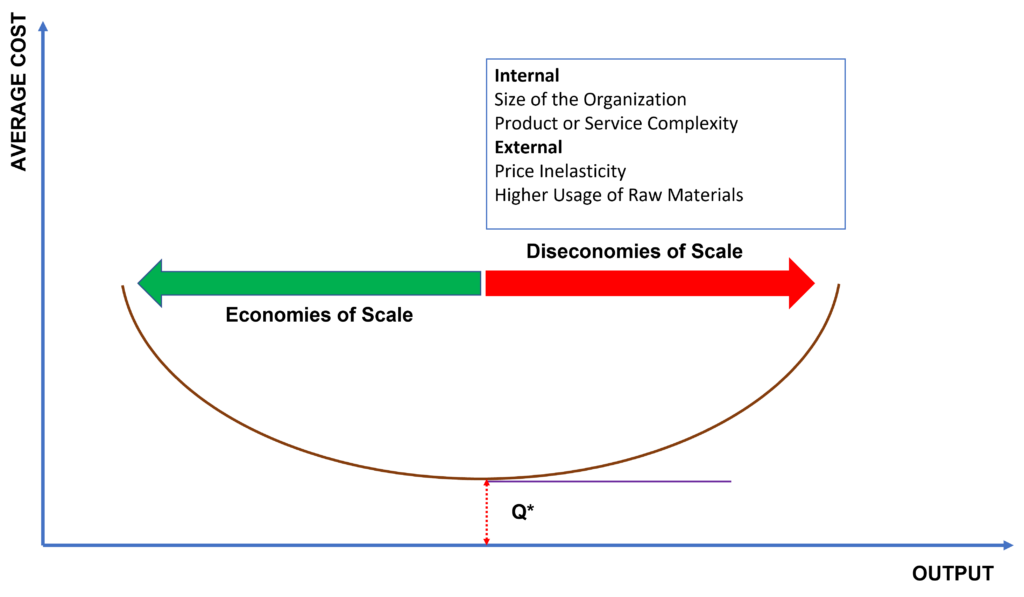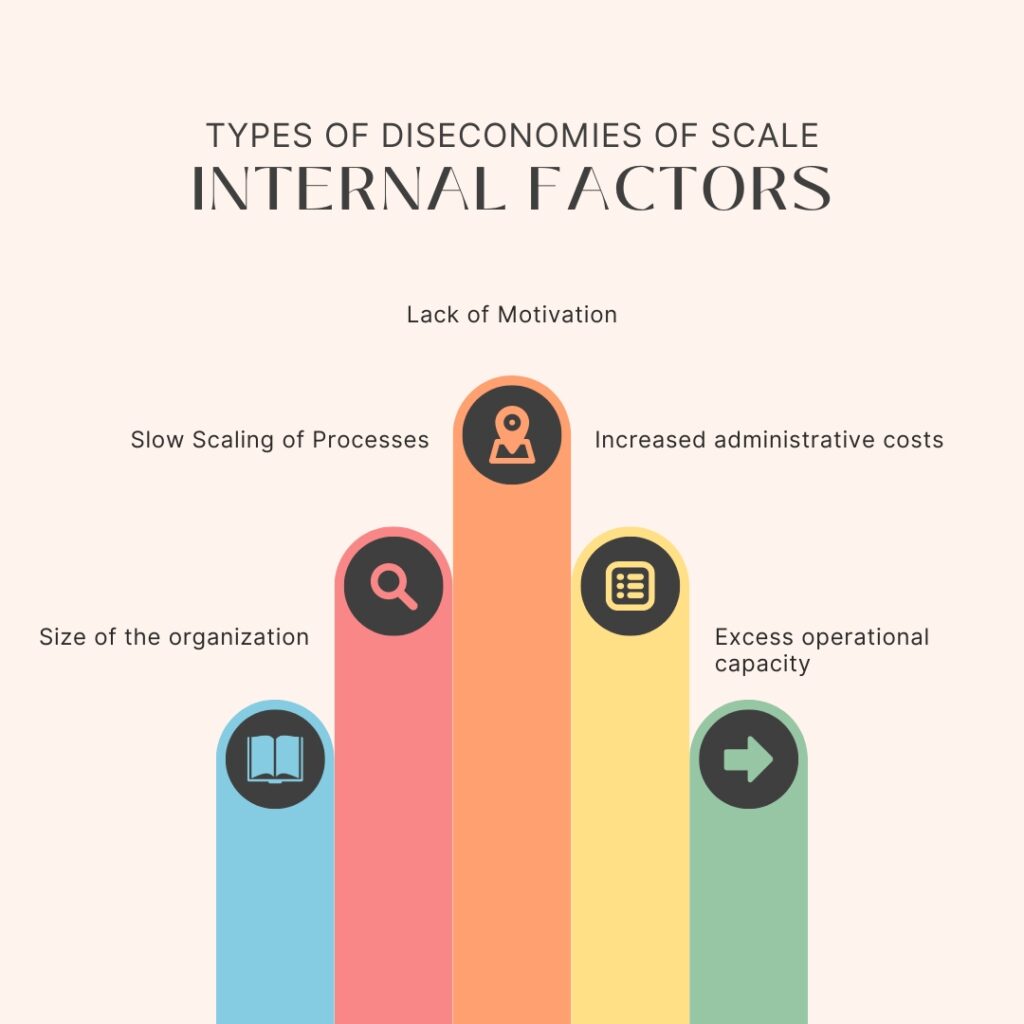Diseconomies Of Scale arise in a business as the scale and scope of the business begin to expand. As businesses grow Knowing what diseconomies of scale are and how they can affect a business is essential for business owners and managers. In this article, we will explore the causes, types, examples, differences, effects, and strategies to counter diseconomies of scale.
What are Diseconomies of Scale?
Diseconomies of scale are the opposite of economies of scale – it is an increase in the average cost of producing a product due to an increase in production. This can be caused by several factors, such as increased labor costs, increased administrative costs, and inefficiencies due to size.
Diseconomies of scale can lead to decreased profitability and increased costs, which can have a significant impact on a business. Understanding what causes diseconomies of scale, the different types, and the effects they can have on a business are essential for business owners and managers.

Types of Diseconomies of Scale
The causes of diseconomies of scale can be categorized as Internal and External.

Internal Factors:
Internal Factors are those which are specifically related to the internal environment of the organization.
- Size: The biggest reason for diseconomies is scale is the size of the organization. The larger size of the organization can trigger a break of the communication chain within the various actors of production without significant investment in IT and processes
- Slow Scaling of Processes: Another reason could be the slow scaling of processes. Even though the organization has grown rapidly the support processes have been slow to scale up resulting in diseconomies of scale
- Lack of Motivation: As a startup, many organizations target hypergrowth resulting in exceptional payouts and dividends for shareholders. However, as an organization matures, these motivational factors get distributed between many participants resulting in smaller payoffs which results in a decrease in motivation
- Administrative cost: As discussed above, diseconomies of scale can emerge from higher administrative and labor forces which increase due to the scale of the organization
- Excessive Operational Capacity: Another reason for diseconomies of scale is the suboptimal performance of operational capacity. For example, if the management decides to add additional capacity by the installation of the machine but the demand does not peak significantly, resulting in poor utilization of operational capacity
External Factors:
The external factors can be attributed to the environment outside the organization

- Price Inelasticity of Supply: The raw materials prices generally do not go down below a certain limit as diseconomies of scale start impacting downward value chains resulting in a cost of the production going up to support additional demand
- The tragedy of commons: It happens when a natural resource is depleted so fast that the rate of consumption outpaces the rate of replenishment. Under such circumstances, the cost of production goes up significantly as the output grows
- Overleveraging: Whenever a production is overleveraged on a certain input like a critical supplier or a country, any adverse impact on those external suppliers can result in the cost of an increased production
- Force of Nature: For Black Swann events or natural calamities, the cost of production grows up significantly as we see in case of natural disasters or during a pandemic as resources become scarce or demand drops significantly
- External Capacity Constraints: External capacity constraints can arise when a shared resource or a local public good cannot meet the increased production demands. This type of diseconomy of scale is exemplified by the congestion on public highways and other modes of transportation required to ship a company’s products.
The majority of these internal factors can be categorized as managerial diseconomies of scale or technical diseconomies of scale.The most common type of diseconomies of scale is the increased cost of labor. As businesses grow, they need to hire more employees to keep up with demand. This can lead to increased costs in wages, benefits, and training.
In addition to labor costs, businesses may also face increased administrative costs due to the increased complexity of managing a larger business. As businesses grow, they need to invest in more sophisticated systems and technology to keep up with the increased demand. This can lead to increased costs in software, hardware, and other IT-related expenses.
Finally, businesses may also face inefficiencies due to their size. As businesses grow, they can become bloated and inefficient due to mismanagement and bureaucracy. This can lead to decreased productivity and increased costs.
reasons for diseconomies of scale
There are several causes of diseconomies of scale that businesses can face. Some of the most common types include:
- Increased Labor Costs: As businesses grow, they need to hire more employees to keep up with demand. This can lead to increased costs in wages, benefits, and training.
- Increased Administrative Costs: As businesses grow, they need to invest in more sophisticated systems and technology to keep up with the increased demand. This can lead to increased costs in software, hardware, and other IT-related expenses.
- Inefficiencies due to Size: As businesses grow, they can become bloated and inefficient due to mismanagement and bureaucracy. This can lead to decreased productivity and increased costs.
- Decreased Productivity: As businesses grow, they can become overwhelmed by the increased demand and complexity. This can lead to decreased productivity and increased costs.
- Increased Risk: As businesses grow, they can become more vulnerable to external risks such as market fluctuations, competition, and changes in technology. This can lead to decreased profitability and increased costs.
Examples of Diseconomies of Scale
There are many examples of this in the real world. One example is Microsoft. As Microsoft grew, it faced increased labor costs due to the need to hire more employees. It also faced increased administrative costs due to the need to invest in more sophisticated systems and technology. Finally, it faced inefficiencies due to its size, which led to decreased productivity and increased costs. Similar examples were found in the case of an Indian Airline named Kingfisher, which could not cope with the sheer speed at which operations were growing along with other failures of management.
Another example is Walmart. As Walmart grew, it faced increased labor costs due to the need to hire more employees. It also faced increased administrative costs due to the need to invest in more sophisticated systems and technology. Finally, it faced increased risk due to the increased vulnerability to market fluctuations, competition, and changes in technology. They had to invest significantly in IT processes and Automation to overcome challenges from Amazon to maintain their core competence in low-cost retail.
Differences between Diseconomies of Scale and Diminishing Marginal Returns
Diseconomies of scale and diminishing marginal returns are often confused, but they are two distinct concepts. Diminishing marginal returns is when the marginal benefit of a product or service decreases as production increases. This is due to the law of diminishing returns, which states that as more of a factor of production is added, the marginal benefit decreases.
On the other hand, diseconomies of scale are when the average cost of producing a product or service increases as production increases. This is due to increased costs in labor, administrative costs, and inefficiencies due to size.
Effects of Diseconomies of Scale
The effects of diseconomies of scale can be significant. As businesses face increased costs, they can become less profitable. This can lead to decreased market share, decreased sales, and decreased customer satisfaction.
In addition, businesses may be forced to increase prices in order to cover increased costs. This can lead to decreased sales and decreased customer loyalty.
Finally, businesses may be forced to reduce their workforce in order to cut costs. This can lead to decreased morale, decreased productivity, and decreased efficiency.
Identifying Diseconomies of Scale
Identifying diseconomies of scale can be difficult, as the signs can be subtle. Businesses can look for warning signs such as increased costs, decreased productivity, and decreased profitability.
In addition, businesses can look for signs of inefficiencies, such as increased bureaucracy and mismanagement. Finally, businesses should keep an eye on external factors, such as market fluctuations, competition, and changes in technology.
Strategies to Counter Diseconomies of Scale
Businesses can use several strategies to counter diseconomies of scale. The most effective strategies include:
- Investing in Technology: Businesses can invest in technology to improve efficiency and reduce costs. This can include investing in software, hardware, and other IT-related expenses.
- Automation: Businesses can automate processes to improve efficiency and reduce costs. This can include investing in robotics, artificial intelligence, and other automation technologies.
- Outsourcing: Businesses can outsource tasks to reduce costs. This can include outsourcing labor, administrative tasks, and other services.
- Reorganization: Businesses can reorganize to improve efficiency and reduce costs. This can include restructuring departments, streamlining processes, and consolidating operations.
Implementing Strategies to Counter Diseconomies of Scale
Once businesses have identified the strategies they need to counter diseconomies of scale, they need to implement them. This can include investing in technology, automating processes, outsourcing tasks, and reorganizing departments.
Each strategy should be tailored to the specific needs of the business. Businesses should consider their budget, timeline, and resources when implementing strategies to counter diseconomies of scale.
Conclusion
Diseconomies of scale can have a significant impact on businesses. Knowing what causes diseconomies of scale, the different types, and the effects they can have on a business are essential for business owners and managers. Businesses can use several strategies to counter diseconomies of scale, such as investing in technology, automating processes, outsourcing tasks, and reorganizing departments. By understanding and countering diseconomies of scale, businesses can remain competitive and profitable in the long term.
Samrat is a Delhi-based MBA from the Indian Institute of Management. He is a Strategy, AI, and Marketing Enthusiast and passionately writes about core and emerging topics in Management studies. Reach out to his LinkedIn for a discussion or follow his Quora Page
